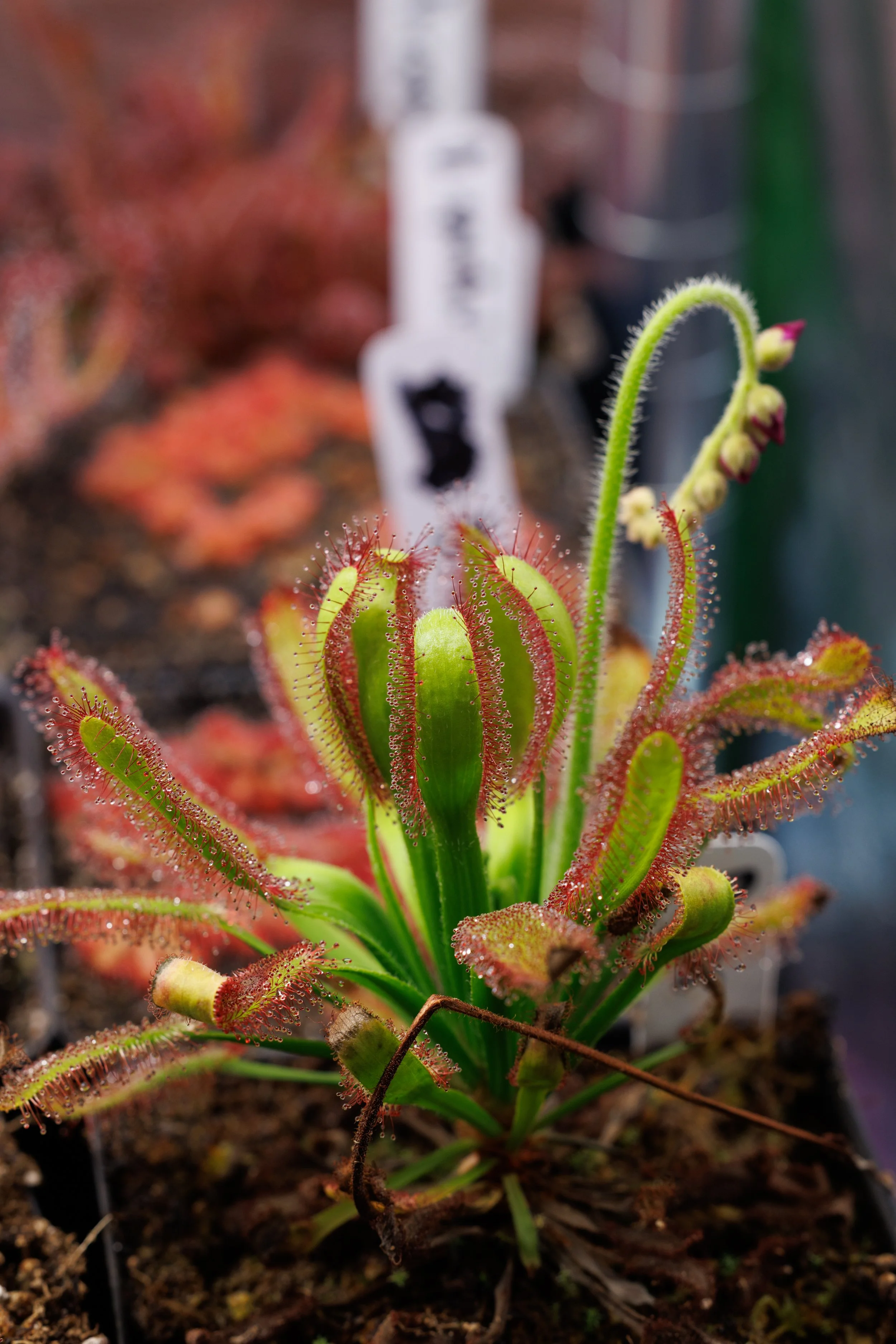 Image 1 of 3
Image 1 of 3

 Image 2 of 3
Image 2 of 3

 Image 3 of 3
Image 3 of 3




Drosera x 'Hercules' [SEEDS]
Description
Drosera x ‘Hercules’ is a vigorous and robust hybrid between Drosera capensis and Drosera aliciae. It looks like Drosera capensis but with extremely wide leaves and a dense growth pattern. Weirdly, it readily self pollinates and produces seed even as a hybrid between two disparate species. The flowers are large and bright purple. Overall, a large and hefty plant that is easy and attractive.
Drosera capensis and Drosera aliciae are two species from South Africa that grow in a Mediterranean climate. While capensis has long, strap-shaped leaves, aliciae has more wedge-shaped leaves. This hybrid was supposedly between capensis “albino” and aliciae so the tentacles stay a lighter red color and the plants remain green, even in strong light.
Each packet of seeds will contain 30+ seeds.
Growing Information
Climate: Temperatures between 40-90F are best. These seem to do fine at different humidity levels.
Light: Part to Full Sun or at least 20W per square foot of LED lighting. These grow best in high light.
Water: Water with the tray method of roughly 1-2” of water. Only use distilled, reverse osmosis, or rainwater because tap water is toxic to carnivorous plants due to high mineral content and chlorine.
Soil: Soil can be 50% peat: 50% perlite, though most peat or sphagnum based mixes will be good.
Feeding: Feed Fish Food Powder or lightly spray leaves with dilute Dynagro Foliage Pro or MaxSea at roughly 200-400ppm. Feed every 2-4 weeks to stimulate strong growth.
Description
Drosera x ‘Hercules’ is a vigorous and robust hybrid between Drosera capensis and Drosera aliciae. It looks like Drosera capensis but with extremely wide leaves and a dense growth pattern. Weirdly, it readily self pollinates and produces seed even as a hybrid between two disparate species. The flowers are large and bright purple. Overall, a large and hefty plant that is easy and attractive.
Drosera capensis and Drosera aliciae are two species from South Africa that grow in a Mediterranean climate. While capensis has long, strap-shaped leaves, aliciae has more wedge-shaped leaves. This hybrid was supposedly between capensis “albino” and aliciae so the tentacles stay a lighter red color and the plants remain green, even in strong light.
Each packet of seeds will contain 30+ seeds.
Growing Information
Climate: Temperatures between 40-90F are best. These seem to do fine at different humidity levels.
Light: Part to Full Sun or at least 20W per square foot of LED lighting. These grow best in high light.
Water: Water with the tray method of roughly 1-2” of water. Only use distilled, reverse osmosis, or rainwater because tap water is toxic to carnivorous plants due to high mineral content and chlorine.
Soil: Soil can be 50% peat: 50% perlite, though most peat or sphagnum based mixes will be good.
Feeding: Feed Fish Food Powder or lightly spray leaves with dilute Dynagro Foliage Pro or MaxSea at roughly 200-400ppm. Feed every 2-4 weeks to stimulate strong growth.
Description
Drosera x ‘Hercules’ is a vigorous and robust hybrid between Drosera capensis and Drosera aliciae. It looks like Drosera capensis but with extremely wide leaves and a dense growth pattern. Weirdly, it readily self pollinates and produces seed even as a hybrid between two disparate species. The flowers are large and bright purple. Overall, a large and hefty plant that is easy and attractive.
Drosera capensis and Drosera aliciae are two species from South Africa that grow in a Mediterranean climate. While capensis has long, strap-shaped leaves, aliciae has more wedge-shaped leaves. This hybrid was supposedly between capensis “albino” and aliciae so the tentacles stay a lighter red color and the plants remain green, even in strong light.
Each packet of seeds will contain 30+ seeds.
Growing Information
Climate: Temperatures between 40-90F are best. These seem to do fine at different humidity levels.
Light: Part to Full Sun or at least 20W per square foot of LED lighting. These grow best in high light.
Water: Water with the tray method of roughly 1-2” of water. Only use distilled, reverse osmosis, or rainwater because tap water is toxic to carnivorous plants due to high mineral content and chlorine.
Soil: Soil can be 50% peat: 50% perlite, though most peat or sphagnum based mixes will be good.
Feeding: Feed Fish Food Powder or lightly spray leaves with dilute Dynagro Foliage Pro or MaxSea at roughly 200-400ppm. Feed every 2-4 weeks to stimulate strong growth.
